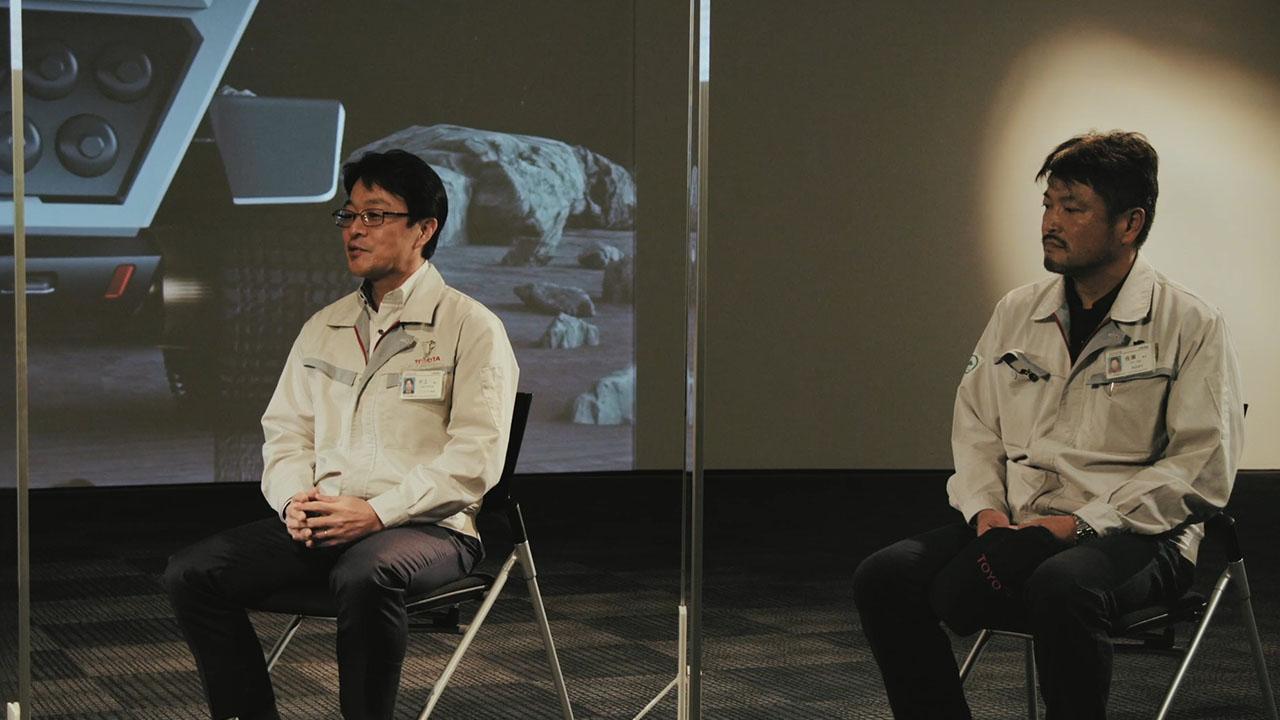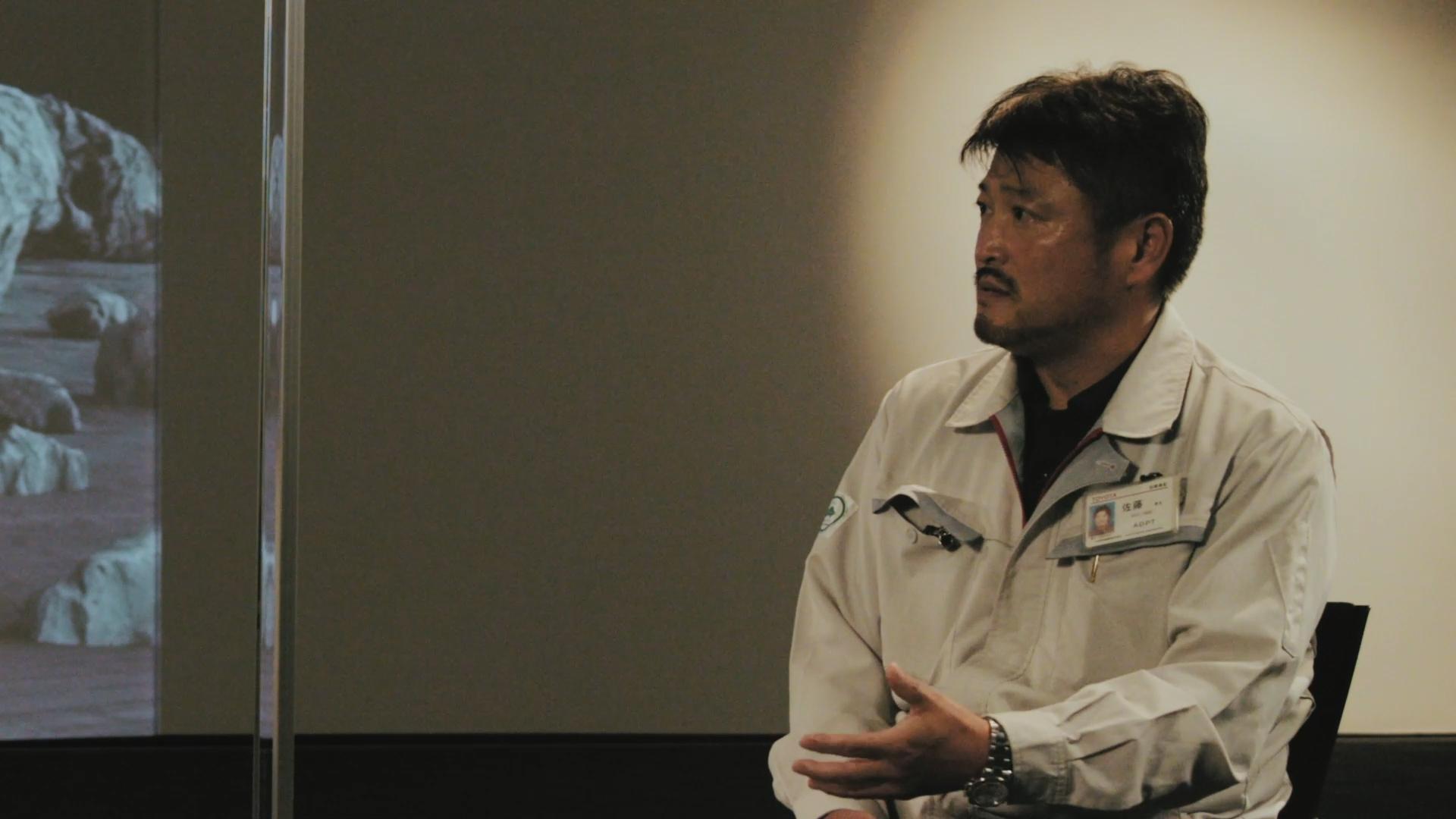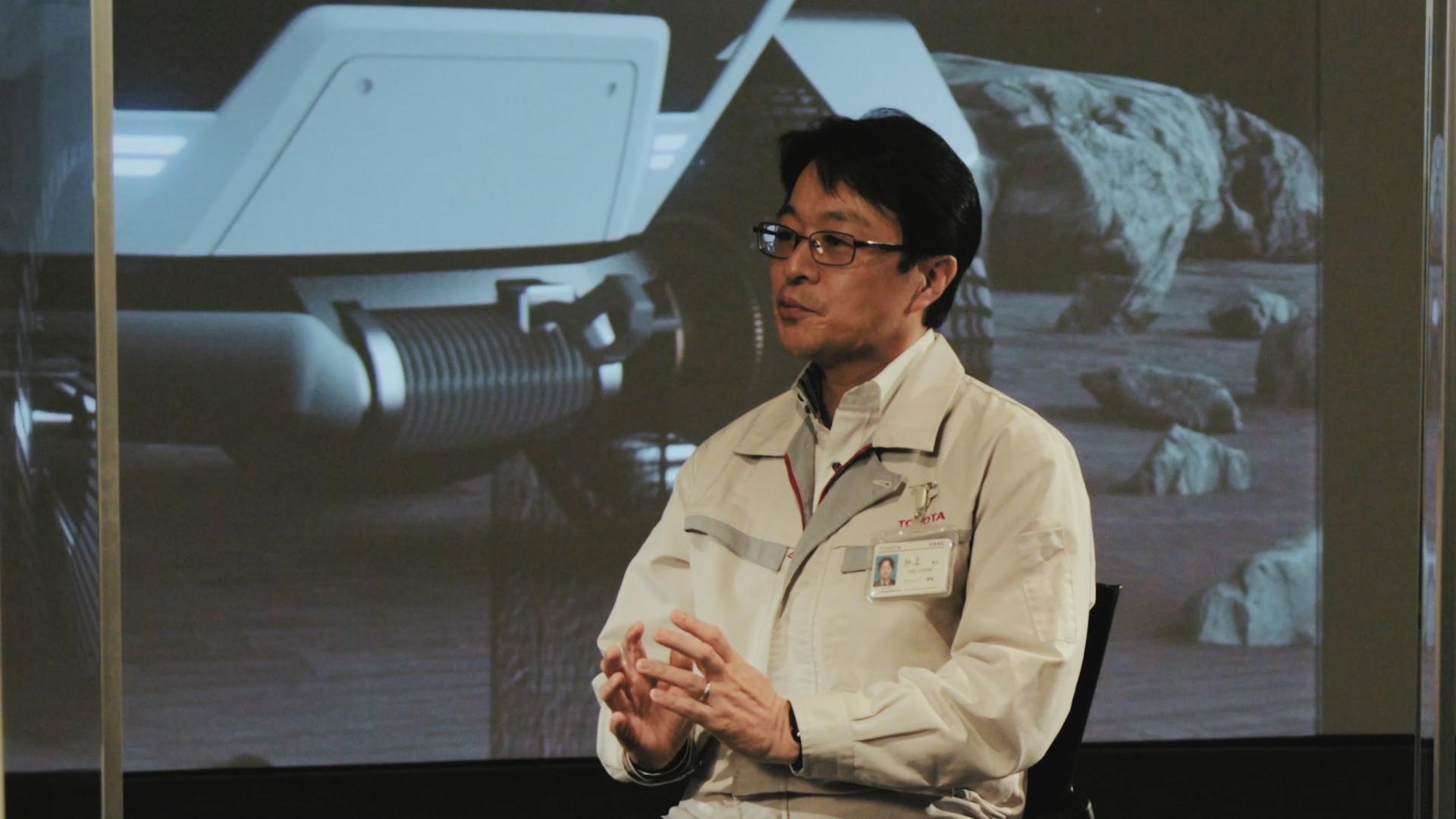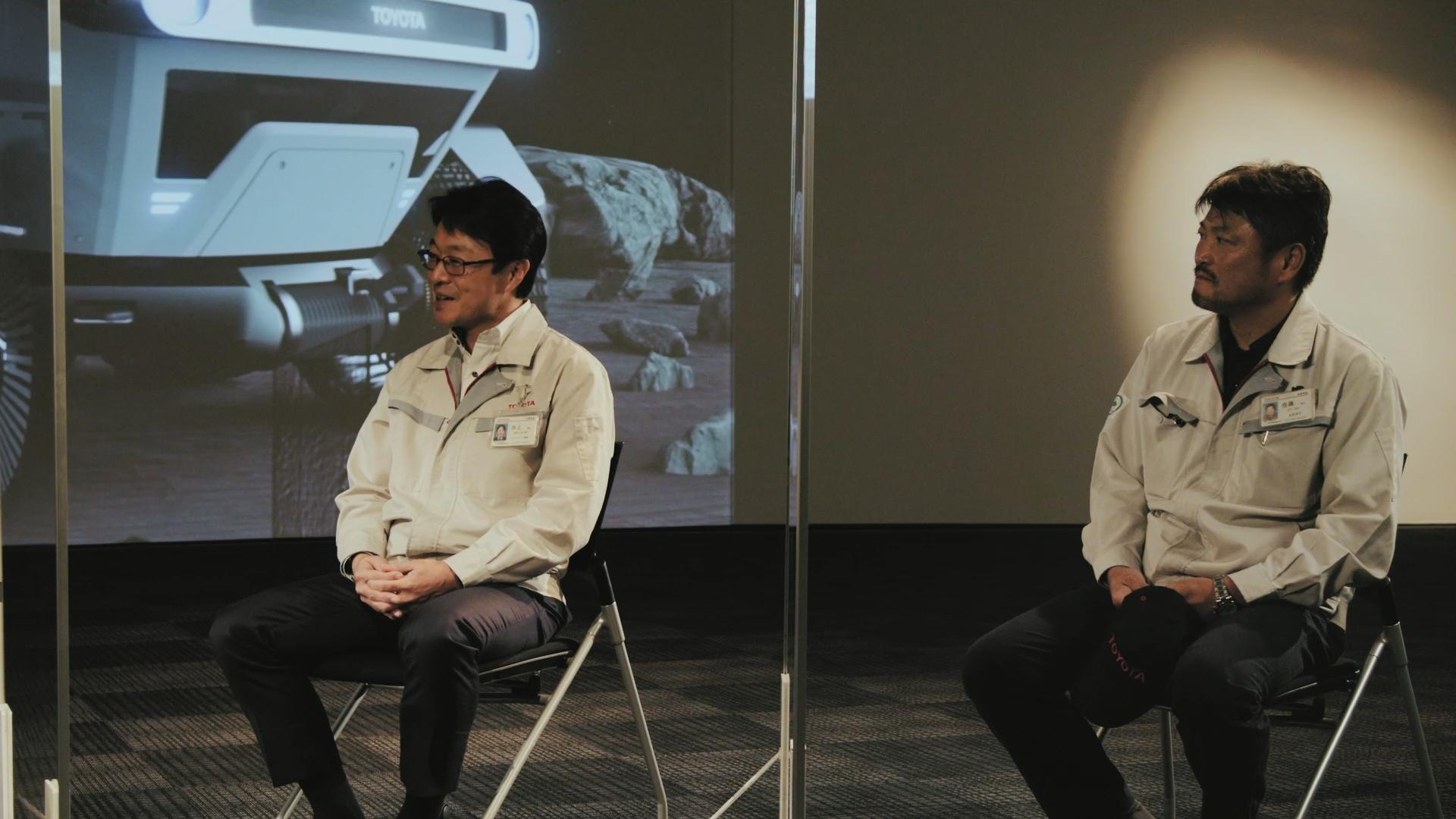2020.09.18

Why develop the lunar rover? What does it have to do with Toyota? Toyota Times seeks more input, this time from Toyota's perspective.

Having visited with astronauts and other staff members from JAXA, including site visits, Toyota Times pivots now to interview Toyota’s Hirofumi Inoue, a leader at the Advanced R&D and Engineering Company, and another leader, Takao Sato, project manager in charge of lunar rover development, also from the Advanced R&D and Engineering Company.
An Enigneer’s dream is to do “what you can’t do”

Toyota Times:
I’m here speaking with Mr. Hirofumi Inoue and Mr. Takao Sato.
Inoue:
Hello
Sato:
Hello
Toyota Times:
I’ve heard JAXA’s view of things, so now I would like to start by asking each of you to share your thoughts on this LUNAR CRUISER from Toyota’s perspective, the mindset behind this one vehicle and how it feels to be a car manufacturer setting out to produce a pressurized crew lunar rover. Can you talk about Toyota’s perspective, the car-oriented perspective, of this project, from start of the project until now, as well as your plans for the future?
Inoue:
Thank you. Since the company’s founding, we have embraced what we call “sangyo hokoku,” a spirit of contributing to the overall good of whatever country we do business in, which has guided our development of cars ever since. We’ve been making cars for around 80 years. When we considered what to make and how to contribute in the next era, this lunar rover project came up.
As you know, our approach has always been based on safety and reliability. Looking towards the future, we have to challenge ourselves further, which will involve new technologies such as CASE. We want to incorporate such technologies to assist in building the future of human beings. The technologies developed through this project, such as fuel cell technology, will naturally feed back down to Earth. Automated driving technologies can also be utilized here. In this way, by taking on this project, we want to reincorporate various technologies for use here on Earth, contributing to society on a planet-wide level.
In order to understand what we don’t know, we first had to thoroughly learn the technical depth and difficulty of what is involved by speaking with senior members in various areas of the space industry. We have been able to set up a lunar surface study group with JAXA and Mitsubishi Heavy Industries under the framework of ‘Team Japan’.
Around 100 companies have now joined in such an initiative, which has allowed us to study the technology from various angles, understand our challenges, and condense all of these ideas. In this respect, I think this approach has given us greater speed as we partner with various players rather than going it alone.
Sato:
Back then, three years ago, at Toyota we were doing things like taking cars around to five different continents and giving our young staff a month or two to drive and learn the roads, to incorporate this knowledge into our cars, with the idea that “roads make people and people make cars.” Talk of this rover came up at that time, when our bosses asked what the sixth continent will be. For us engineers, finding that new road was a grand dream. So to do what hasn’t been done before is an engineer’s dream, which made us think, right, let’s give this a shot.
When we set out, there were so many things that we didn’t know, as you’ve seen today. We started out feeling dazed and shaken, but our young staff were determined to do it, so we set out to give them the support they needed.
Conquering the harsh environment of the Moon will greatly boost the capabilities of our engineers. I see these capabilities as the ability to take on future challenges, and I hope that’s how this development project contributes to later endeavors.
The project consists of members from various backgrounds. At the moment, car development work is highly subdivided, which means that the tasks of every worker are strictly prescribed to improve efficiency. But broadly speaking, each of the 30 people here is creating an automobile, creating this lunar rover. I feel that approaching the task with this mindset also helps to nurture the people who are involved.
Inoue:
I hope this contributes to the making of both our people and products, and I want to do my part in supporting that process.
Toyota Times:
So this is about nurturing people, after all?
Inoue:
Yes.
Toyota Times:
Because it is people that make cars.
Inoue:
That’s right, I really feel that way.
I’m here speaking with Mr. Hirofumi Inoue and Mr. Takao Sato.
Inoue:
Hello
Sato:
Hello
Toyota Times:
I’ve heard JAXA’s view of things, so now I would like to start by asking each of you to share your thoughts on this LUNAR CRUISER from Toyota’s perspective, the mindset behind this one vehicle and how it feels to be a car manufacturer setting out to produce a pressurized crew lunar rover. Can you talk about Toyota’s perspective, the car-oriented perspective, of this project, from start of the project until now, as well as your plans for the future?
Inoue:
Thank you. Since the company’s founding, we have embraced what we call “sangyo hokoku,” a spirit of contributing to the overall good of whatever country we do business in, which has guided our development of cars ever since. We’ve been making cars for around 80 years. When we considered what to make and how to contribute in the next era, this lunar rover project came up.
As you know, our approach has always been based on safety and reliability. Looking towards the future, we have to challenge ourselves further, which will involve new technologies such as CASE. We want to incorporate such technologies to assist in building the future of human beings. The technologies developed through this project, such as fuel cell technology, will naturally feed back down to Earth. Automated driving technologies can also be utilized here. In this way, by taking on this project, we want to reincorporate various technologies for use here on Earth, contributing to society on a planet-wide level.
In order to understand what we don’t know, we first had to thoroughly learn the technical depth and difficulty of what is involved by speaking with senior members in various areas of the space industry. We have been able to set up a lunar surface study group with JAXA and Mitsubishi Heavy Industries under the framework of ‘Team Japan’.
Around 100 companies have now joined in such an initiative, which has allowed us to study the technology from various angles, understand our challenges, and condense all of these ideas. In this respect, I think this approach has given us greater speed as we partner with various players rather than going it alone.
Sato:
Back then, three years ago, at Toyota we were doing things like taking cars around to five different continents and giving our young staff a month or two to drive and learn the roads, to incorporate this knowledge into our cars, with the idea that “roads make people and people make cars.” Talk of this rover came up at that time, when our bosses asked what the sixth continent will be. For us engineers, finding that new road was a grand dream. So to do what hasn’t been done before is an engineer’s dream, which made us think, right, let’s give this a shot.
When we set out, there were so many things that we didn’t know, as you’ve seen today. We started out feeling dazed and shaken, but our young staff were determined to do it, so we set out to give them the support they needed.
Conquering the harsh environment of the Moon will greatly boost the capabilities of our engineers. I see these capabilities as the ability to take on future challenges, and I hope that’s how this development project contributes to later endeavors.
The project consists of members from various backgrounds. At the moment, car development work is highly subdivided, which means that the tasks of every worker are strictly prescribed to improve efficiency. But broadly speaking, each of the 30 people here is creating an automobile, creating this lunar rover. I feel that approaching the task with this mindset also helps to nurture the people who are involved.
Inoue:
I hope this contributes to the making of both our people and products, and I want to do my part in supporting that process.
Toyota Times:
So this is about nurturing people, after all?
Inoue:
Yes.
Toyota Times:
Because it is people that make cars.
Inoue:
That’s right, I really feel that way.
Using kaizen to overcome things you can’t do

Toyota Times:
Since last year, I’ve had many chances to test ride Toyota’s automated driving vehicles, and the Guardian system that Toyota is currently developing, based on artificial intelligence, the AI – I also feel like that will be very important to this LUNAR CRUISER.
Inoue:
Yes. The conditions are far harsher than roads here on Earth, with rocks and craters. Using image processing to avoid dangers is precisely what the Guardian does, but it will need to do this in a harsher environment. Naturally, I think that technology can also be utilized back on Earth.
While we view safety as essential, beyond that there is what you might call confidence or reliability. you commented on how good the automated driving was, as if someone was there, and we want to raise the technology to that level of being able to put your trust in it. By doing so, we can give those on board greater peace of mind, and this is another aspect that makes me eager to take the project further.
Toyota Times:
From being involved in the development of this LUNAR CRUISER, this project to send a pressurized crew rover to the Moon, what do you both see anew as Toyota’s strengths?
Inoue:
I would have to say “people.”
Of course, there are also things like our technical strengths that have underpinned the safety and reliability of our cars, but more than that, people have the ability to act based on rules and principles – when faced with particularly difficult challenges, it is in our DNA to try and make the impossible possible through the process of kaizen (continuous improvement). We can also work as a team, as partners, and colleagues, all of which contributes to help achieving the goal. When it comes down to it, I think that this is the DNA of Toyota people that is extremely effective and important.
Toyota Times:
Indeed. Mr. Sato, how about you?
Sato:
Well, as with our current members, it is about having the desire to tackle challenges, even when the work might not be glamorous. Even when the work is unpleasant and far from glamorous, they tackle each of these tough tasks with the concept of kaizen – I don’t know if ‘spirit’ is putting it too strongly, but I see that honest, diligent aspect as our strength.
Inoue:
That’s it. We are keenly conscious of what has been built up by those who came before us, the trust and the past achievements, and we want to pass that on to the next generation as well. Hearing that makes me eager to work harder to ensure that this DNA, and our manufacturing capabilities, carry on for a long time, even after we’re gone.
Since last year, I’ve had many chances to test ride Toyota’s automated driving vehicles, and the Guardian system that Toyota is currently developing, based on artificial intelligence, the AI – I also feel like that will be very important to this LUNAR CRUISER.
Inoue:
Yes. The conditions are far harsher than roads here on Earth, with rocks and craters. Using image processing to avoid dangers is precisely what the Guardian does, but it will need to do this in a harsher environment. Naturally, I think that technology can also be utilized back on Earth.
While we view safety as essential, beyond that there is what you might call confidence or reliability. you commented on how good the automated driving was, as if someone was there, and we want to raise the technology to that level of being able to put your trust in it. By doing so, we can give those on board greater peace of mind, and this is another aspect that makes me eager to take the project further.
Toyota Times:
From being involved in the development of this LUNAR CRUISER, this project to send a pressurized crew rover to the Moon, what do you both see anew as Toyota’s strengths?
Inoue:
I would have to say “people.”
Of course, there are also things like our technical strengths that have underpinned the safety and reliability of our cars, but more than that, people have the ability to act based on rules and principles – when faced with particularly difficult challenges, it is in our DNA to try and make the impossible possible through the process of kaizen (continuous improvement). We can also work as a team, as partners, and colleagues, all of which contributes to help achieving the goal. When it comes down to it, I think that this is the DNA of Toyota people that is extremely effective and important.
Toyota Times:
Indeed. Mr. Sato, how about you?
Sato:
Well, as with our current members, it is about having the desire to tackle challenges, even when the work might not be glamorous. Even when the work is unpleasant and far from glamorous, they tackle each of these tough tasks with the concept of kaizen – I don’t know if ‘spirit’ is putting it too strongly, but I see that honest, diligent aspect as our strength.
Inoue:
That’s it. We are keenly conscious of what has been built up by those who came before us, the trust and the past achievements, and we want to pass that on to the next generation as well. Hearing that makes me eager to work harder to ensure that this DNA, and our manufacturing capabilities, carry on for a long time, even after we’re gone.
Aiming to develop the ultimate saloon car in history

Toyota Times:
In that case, you have to make this the ultimate saloon car in history, to create that environment. When I was growing up, my mother and I rode in a Century, and to me, it felt fit for a king. I have shared such personal experience in the flagship car with President Toyoda. With Toyota having produced a car like the Century, I can’t help but expect that you will create a really impressive space in [the rover], and I’m sure you can make that possible. At the same time, it also has to have the power to run like a workhorse, doesn’t it?
Earlier, I had a ride in the buggy, with Mr. Kouno gunning it, and that really felt like you could move those six wheels with a finger – but if you don’t have that vital element, you’d just end up burning through the hydrogen at a rapid pace. So there’s that aspect of it, too.
Inoue:
Yes, you’re right.
Toyota Times:
It’s incredibly important, and the technical challenge is also important.
Inoue:
That’s right. We are facing a very harsh environment, so I really want to make a vehicle that moves as intended, while minimizing the burden on the people inside.
Toyota Times:
Especially, with it being as large as it is. So make it move as intended, and then, when it comes to time to rest, you want the astronauts to feel like the day wasn’t something to be endured. That would be ideal, wouldn’t it?
Inoue:
I completely agree with that. That’s truly what we want to achieve.
Toyota Times:
In 9, or rather 8 years.
Inoue:
Then we’re off.
Toyota Times:
You are hoping that Bridgestone will be able to do three rounds of development this year.
Inoue:
Earlier on, Mr. Kouno from Bridgestone said that Toyota’s requirements are too demanding, but the fact is that the conditions on the Moon are demanding.
Toyota Times:
I see, so it’s not just you guys being needlessly strict.
Inoue:
That’s right.
Toyota Times:
So that's all cleared up?
Inoue:
The Moon’s environment is harsh, that’s all.
Toyota Times:
The Moon’s environment is harsh, so you have to… you’re just passing on that message, as it were.
Inoue:
That’s right, that’s all it is.
In that case, you have to make this the ultimate saloon car in history, to create that environment. When I was growing up, my mother and I rode in a Century, and to me, it felt fit for a king. I have shared such personal experience in the flagship car with President Toyoda. With Toyota having produced a car like the Century, I can’t help but expect that you will create a really impressive space in [the rover], and I’m sure you can make that possible. At the same time, it also has to have the power to run like a workhorse, doesn’t it?
Earlier, I had a ride in the buggy, with Mr. Kouno gunning it, and that really felt like you could move those six wheels with a finger – but if you don’t have that vital element, you’d just end up burning through the hydrogen at a rapid pace. So there’s that aspect of it, too.
Inoue:
Yes, you’re right.
Toyota Times:
It’s incredibly important, and the technical challenge is also important.
Inoue:
That’s right. We are facing a very harsh environment, so I really want to make a vehicle that moves as intended, while minimizing the burden on the people inside.
Toyota Times:
Especially, with it being as large as it is. So make it move as intended, and then, when it comes to time to rest, you want the astronauts to feel like the day wasn’t something to be endured. That would be ideal, wouldn’t it?
Inoue:
I completely agree with that. That’s truly what we want to achieve.
Toyota Times:
In 9, or rather 8 years.
Inoue:
Then we’re off.
Toyota Times:
You are hoping that Bridgestone will be able to do three rounds of development this year.
Inoue:
Earlier on, Mr. Kouno from Bridgestone said that Toyota’s requirements are too demanding, but the fact is that the conditions on the Moon are demanding.
Toyota Times:
I see, so it’s not just you guys being needlessly strict.
Inoue:
That’s right.
Toyota Times:
So that's all cleared up?
Inoue:
The Moon’s environment is harsh, that’s all.
Toyota Times:
The Moon’s environment is harsh, so you have to… you’re just passing on that message, as it were.
Inoue:
That’s right, that’s all it is.

